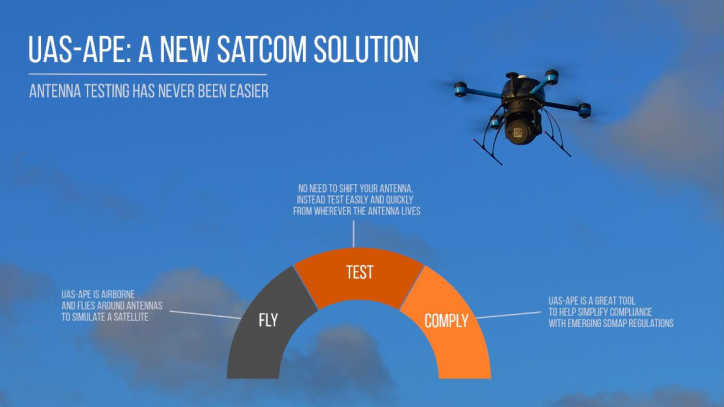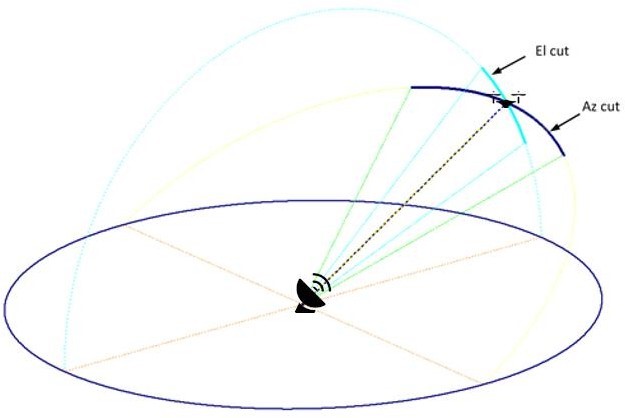
-
StatusOngoing
-
Status date2020-03-04
-
Activity Code7C.054
QuadSAT’s UAS-APE system uses drone technology to complete performance measurements on VSAT antennas, specifically Communications-On-The-Move products. The system functions as a portable test range which provides high-precision off and on-axis measurements.
The result is a portable, cost-effective, and time-efficient method to verify antenna performance. The system facilitates a wide variety of testing scenarios for satellite operators and antenna manufacturers onsite after new installations.
Typical measurements include principal cuts in azimuth and elevation, as well as raster scans. The system is offered for use as a worldwide service or can be purchased as a product.
The project’s key objective is to introduce a complete system to the SatCom industry which is faster, easier, and more affordable to use than the current traditional way of testing antennas.


A key challenge of the project is the modular integration of different systems to fulfil the strict requirements in terms of signal amplitude and frequency stability. The UAS system presents both traits but also difficulties, due to numerous disturbances as well as necessity for intensive tuning.
Another key challenge is the integration between the system’s software and hardware, for a flawless user experience. Developing a system which is to be operated in field requires great knowledge of the involved process as well as of potential problems that might arise.
QuadSAT’s current system requires manual data processing and integration, which is time consuming. The outcome of the project is a stand-alone system which automates data processing and integration.
The UAS-APE system provides a faster and easier alternative to traditional testing methods.
Traditional testing methods involve the laborious process of dismounting the antenna and transporting it to the nearest testing facility, where testing can take up to a week, then transporting it back to its home.
Comparatively, when using the UAS-APE, the compact and portable drone system is taken directly to the antenna’s home and the test is performed in-field in a matter of hours.
This turns a very time-heavy and resource-heavy process into a far easier process, which will hopefully ultimately allow for testing to be performed more frequently, resulting in cleaner signals overall.
The traditional way of testing, at testing ranges, involves physically manipulating the antenna to achieve their results. In comparison, QuadSAT’s UAS-APE system features a drone, which allows SatCom professionals to test without manipulating the antenna, since the drone is dynamic and flies around the antenna to achieve pattern cuts. This makes the testing process faster and overall more resource efficient.
Additionally, the small physical size of the system allows for high portability. One of the capabilities of the product is that it is easily
portable to practically anywhere in the world and is thus convenient to use.
UAS-APE provides a reliable method of identifying the transmit co-polar and cross-polar off axis components of a satellite antenna, using an unmanned aerial system.
The system can perform the following measurements:
- Principal cuts in Azimuth & Elevation.
- Raster scans.
- Gain, beam-width and cross-pol discrimination measurements. The system is designed for Ku-band (with X & Ka band in Q2-2020).
The measurements are taken in the far-field region and can be performed with or without an antenna radome.
The cuts are performed by flying the UAS in a user preprogramed flight plan, whilst keeping the antenna pointing fixed.
The system currently requires two operators: one UAS operator and one technician for the control of the ground station.
Test results are documented in a report, and based on customer preferences, selected overlaying masks can be applied.
Other preferences in terms of data handling, comparison between different antennas, et cetera, can be performed upon customer request.

The aim of the project is to design and develop the test solution to the point where its results can be compared with traditional test methods.
The initial phase is focused on identifying a suitable design able to fulfil the demands of the satellite operators.
The main design components are the RF module, mechanical module, UAS module, control logic, system architecture, and GUI.
The project has two prototyping stages. The first is aimed at testing the overall concept/design and the integration of all the modules together, and the second, based on feedback from customers and tests, is the finalized unit which will be demonstrated and verified by satellite operators.

The latest prototype version has been demonstrated in September 2019 at Austria’s A1 Telekom Aflenz teleport.
A series of tests were carried out, witnessed by SES, Eutelsat, A1 Telekom, and Mike Bartlett (Mik The Dish), an independent antenna verification engineering consultant.
The tests included horizontal and elevation off-axis radiation diagrams, cross-pol measurements, and raster scans created using QuadSAT’s system.
The results of the demonstration have been positive, and the team has received valuable feedback from the two satellite operators.





